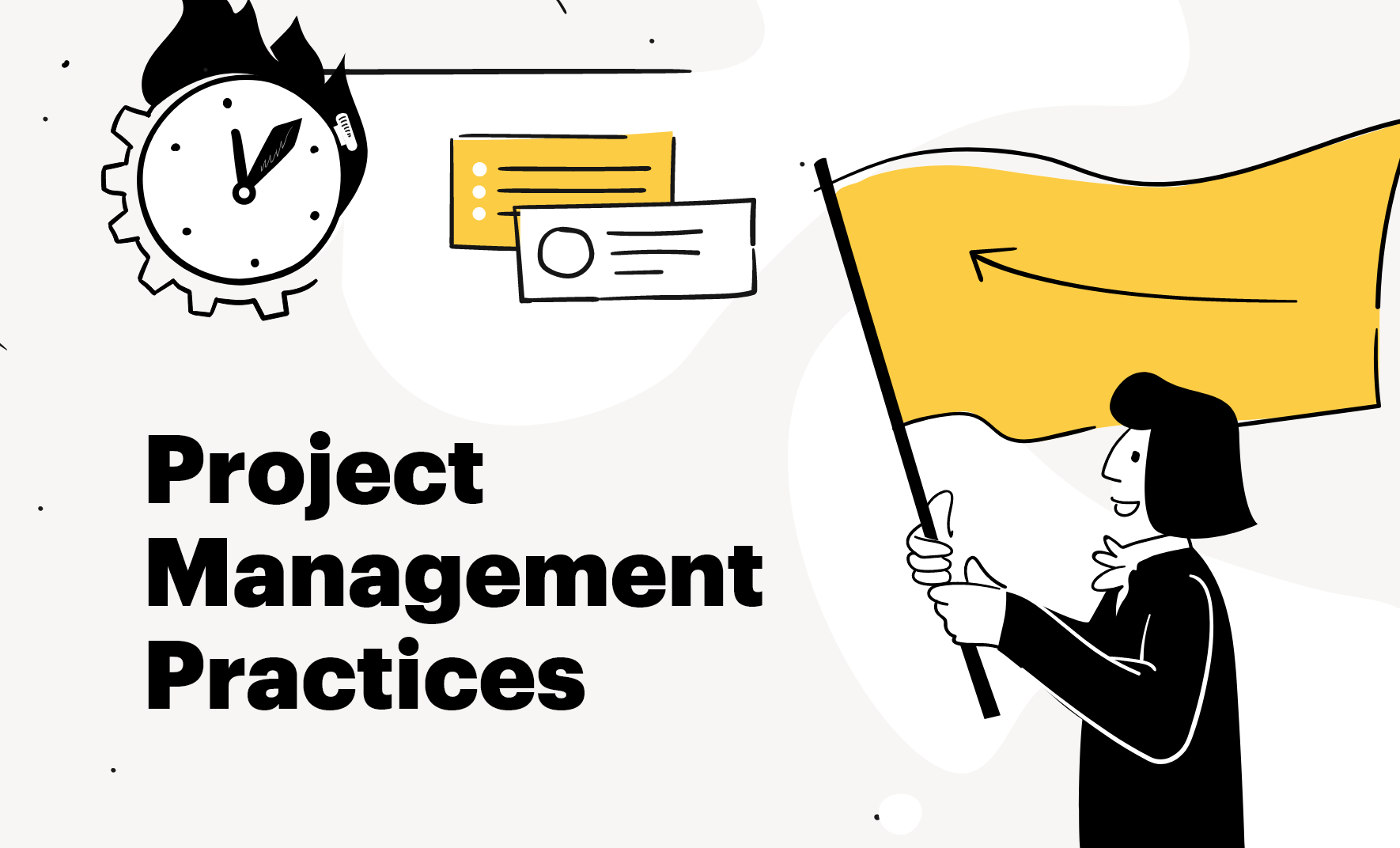The 12 Project Management Best Practices You Can Start Implementing Now

No matter if you are an experienced project manager or you are just starting out, there always be new things to learn and to constantly upgrade your ways of doing things.
Because of the uniqueness and complexity of projects, you will need to create and follow your own system for navigating through your endless projects. Without having such a system, you might find yourself overwhelmed with tasks and issues, and not knowing where to start.
In this article, we talk about project management best practices – tested over time, they prove to be an invaluable tool for project management and keeping your projects on the right track.

What Are the Project Management Best Practices?
Project management best practices are techniques, guidelines, ethics, methods, or processes, more efficient and effective in achieving a goal compared to other techniques and methods.
They are based on experience and they describe following a certain standard of doing things.
These practices derive from project management methodologies, international standards, industry conventions, and the company’s own guidelines. For that reason, they might vary from organization to organization, however, they are usually applicable to most cases. Following them can drastically improve project quality and help you achieve your business goals.

The Project Management Best Practices in a Nutshell
First, let’s start with a quick overview list of the project management best practices. Afterward, we’ll look at each one of them in more depth. So here are the key points:
- Ensure that everyone involved understands the requirements and scope for the project
- Ensure a risk response
- Delegate tasks and provide training for your team
- Involve your team in time estimates
- Develop both technical and leadership skills
- Create quality standards for each project’s stage
- Enable transparency for your projects
- Regular check-ins
- Learn to deal with escalating issues
- Have people trained for specific tasks and monitor workloads
- Have regular status meetings with clients
- Hold a project conclusion meeting
Now let’s see why these 12 practices are important and how they can make a huge difference in your work.

How to Implement the 12 Project Management Best Practices
Let’s take each one of the 12 points above and discuss them one by one:
1. Ensure that everyone involved understands the requirements and scope of the project.
As a project manager, you will be mainly dealing with two groups of people – your team and the stakeholders.
Make sure that the stakeholders know what the project deliverables are, what is the definition for their “completeness”. You will also have to be on the same page for budget, project risks, and constraints; you will have to set the quality standards.
For your team, you can create the so-called RACI matrix, which is a simple planning chart. RACI stands for:
- responsible
- accountable
- consulted
- informed
Once you’ve familiarized your team with the project scope, quality standards, and time frames, you need to divide the tasks. By using RACI, you will easily make clear for your team, who is responsible for what, who will be consulting, who needs to be informed, and how the tasks relate to each other.
2. Ensure a risk response
Many things can go wrong in your project – a key resource might drop out, a stakeholder might pull funding, and an important tech component might break.
One of the project management best practices is to create a risk response team. It should be comprised of experienced team members who have access to the project and can monitor and control risks. They should have the training to react in emergency situations.
The next important thing is to be able to take corrective action decisions. You shouldn’t rely solely on your team to put the project back on track. This is why you would want to have clear procedures to correct the situation, including trade-offs, such as increasing costs to save time, decreasing scope to save time. Or as last resort – resetting the project performance baseline. It is one of the main roles of a project manager to carefully evaluate the situation and take these decisions.
3. Delegate tasks and provide training for your team
You need to identify, develop and formalize some of the roles of your project members.
For example, a senior developer might assist in developing schedules, but they will often need some more knowledge and experience in project management. This will help them become better when dealing with project scheduling.
The reason why this is one of the most important best practices is that project managers can’t do all the project work by themselves. That’s why they need to involve team members as much as possible and introduce them to the project’s process. Delegating responsibilities is a great way to give you more room for planning and also help your team grow.
4. Involve your team in time estimates
Often you will find that you don’t have all the necessary info to make accurate time estimates. Involving your team members in the process can make your project planning more successful. Furthermore, your team will be happier to work with more realistic timeframes. |As a result, burnouts, mistakes, and frustrations can be easily avoided.
5. Develop both technical and leadership skills
As important it is to have technical knowledge about your work, it might be even more important to develop your leadership skills. This project management best practice includes understanding the needs of your clients, the end-users, the problems and challenges of your team. Leadership also means being developing your empathy skills to be able to put yourself in someone else’s shoes. This will, without a doubt, will help you communicate better and achieving better results much easier.
Simply put, focus some of your energy on getting better at communication – active listening, asking for feedback, having regular check-ins with both your clients and team members.
6. Have quality standards for each project’s stage
There are more advantages to checking the quality of a project throughout its whole life cycle, instead of checking the quality in the end. In the second case, there’s the risk of having things go wrong without the possibility to change them. Quality standards for each phase leave very little room for mistakes.
Here are some things you can try to ensure quality at each stage:
- Break the project into multiple stages and get stakeholders to sign them off
- Create some criteria for quality measurement; if it’s hard to do it, compare to some industry benchmarks or the client’s past projects
- Provide data when you can – if you are developing a product, make tests to show how the product is better compared to the previous situation
7. Enable transparency for your projects
Another project management best practice is to ensure transparency for your projects.
This means showing your team members how their tasks relate to each other – it affects productivity, collaboration and increases the individual sense of responsibility. It will also encourage them to participate in the decision-making process.
It’s also advisable to establish a task limit by limiting the number of tasks a team member is supposed to execute at one time. This limit will be based on a realistic evaluation of the duration and difficulty of the tasks.
Another way to increase the transparency of the project is to share, when suitable, the budget and time available, impacting the team’s work – this will help team members set their own priorities and handle deadlines better.
In case there are any changes in the project’s scope, budget, or deadline, you can inform your team on time. This step will definitely improve the team’s morale and help them execute tasks with less stress.
8. Regular check-ins
You will easily track progress on tasks, challenges, how they will affect the main schedule by communicating with your team and learning the overall mood and work environment. It signals your people that there is someone to help them improve, when necessary.
You can establish a certain time for check-ups in advance so that you create a habit for your team members and give them time to prepare.
Check-ins are even more important if you have remote employees. According to a survey, 46% out of 1,100 remote workers claim the most successful managers checked in regularly with them.
9. Learn to deal with escalating issues
This project management practice might be the least of your favorites, however, it is important for your project’s success. By breaking it down into simple procedures, it would be much easier.
Here are some useful tips you can use:
- Create a culture where team members are comfortable communicating issues to higher management without fear;
- Escalate only one issue to only one stakeholder at a time and don’t involve the ones who aren’t affected by the issue;
- Create a process to identify the intensity of an issue and have the following procedures to handle it;
10. Have people trained for specific tasks
To maximize the impact of your resources train part of your team to become experts in specific, repetitive tasks. These people would move from project to project, performing target tasks, saving you time, by being more effective by other, less trained team members. Remember to select people who have demonstrated comfort in task switching, otherwise, your strategy won’t work as planned.
Another tip is to assign tasks with limited cognitive impact to people who are part of multiple teams. This way, you keep your team members safe from burnouts and offer them some degree of diversity in their work. We all know that repetitive tasks can kill enthusiasm rather quickly.
Hot to check if team members are still productive, juggling between different projects? Monitor the project’s performance and reduce membership to multiple projects, if you notice a decrease in productivity.
11. Have regular status meetings with clients
We already mentioned how important it is to have regular check-ins with your team – the same counts for meetings with your client. This way you build trust with the client, you make sure you are still on the same page and that project criteria is met and quality ensured.
Not in last place, unless you check-in regularly, you will never know if the client is truly satisfied or not with the progress, and that can be dangerous for the final outcome of the project.
12. Hold a project conclusion meeting
During a project conclusion meeting, you can cover your successes, setbacks, and lessons learned during the project, plus improvements to be made in the future.
This is also a great time to thank everyone for their hard work and recognize high points of the projects and achievements of the team.
Some tips we can give you for your final meeting is to assign someone to take notes and to send out an agenda beforehand – this gives attendees time to prepare questions, sum up ideas, feedback and concerns.

Ok, we understand that sometimes descriptions and list of points might not be enough for those, hungry for knowledge, so we also gathered some examples in the form of case studies and books. This way, you can read more on the topic and educate yourself even further.
Project Management Case Studies
1. PM Solutions case studies
At PM Solutions you can find many case studies on the topics of mentoring, resource management, process improvement and other.
The short case studies are well-structured and easy to read.
2. Project Management: Case Studies by Harold Kerzner
The entire book is dedicated to project management case studies. You can download the free pdf and read about project planning and estimating, conflict management, managing scope changes, morality and ethics, and more.

3. Project Management Best Practices: Achieving Global Excellence 4th Edition
Examines the role of the Web project manager, and offers strategies for running productive meetings, winning the confidence of the team, dealing constructively with conflict, and managing expectations.
Beginning by outlining the responsibilities of the project manager, this book covers team assembly and communication, project definition, change management, planning strategies, and workflow before moving on to the design, build, and delivery stages. The book’s accessible format also provides immediate hands-on solutions for project managers seeking a quick answer to a particular problem.
4. Being an Effective Project Manager: Your Guide to Becoming a Project Management Rock Star
This book gives a thorough overview of the role of a project manager, including topics like:
- staying organized
- how to stay on track
- remaining accountable
- the importance of doing the right thing at the right time
The book also has a very high rating from readers, all of them appreciating the quick and easy-to-understand tips, ready to be applied in practice.
5. The Human Factor in Project Management
In your role as a project manager, sponsor, owner, etc, the book challenges you to question the choices you make in a series of stories. This book forces you to look beyond the limitations of a Gantt chart, a Kanban board or else and evaluate the tools you use.

Final words
“Since projects are generally perceived to be unique, it cannot be expected that the same set of processes and methods will foster the success of each and every project” (Ahlemann, Teuteberg, Vogelsang, 2009, pp. 294).
We agree to some extent with this statement – project management best practices can help you achieve your project goals, however, it is up to you to determine which ones can be generally applied to your style of work and which are appropriate in any specific situation!
No matter the case, this list of project management best practices is a good starting point for you to explore and upgrade your management skills.
We hope that this article inspired you to dive and learn more about project management. If that’s the case, we also recommend you to check out What Does a Project Manager Do: The Complete Guide.